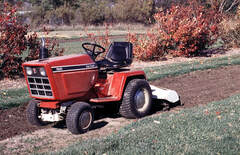 Peas can be planted earlier in the spring than just about any other vegetable crop because they can grow well at a soil temperature of 40 degrees. Though other crops such as lettuce, parsnips and spinach can sprout at lower temperatures (35 degrees), they don’t start growing well until the soil reaches about 45 degrees. However, soils are often too wet to work in the spring. Therefore, you may wish to prepare the soil now rather than next spring so that planting can take place as early as possible even if those spring soils are wet. Wait until soil temperatures reach 40 degrees next spring and sprinkle the seeds on the soil and push them in with your finger. Protection from rabbits and deer will probably be needed as they will be attracted to anything green coming up so early. (Ward Upham) 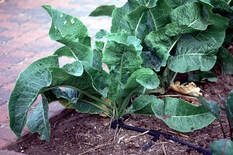 Horseradish is ready to dig after a hard freeze kills the foliage (usually November or December). The large roots can be harvested while smaller, pencil sized roots can be cut in 6-8 inch long sections as 'seed' or 'sets' for next year's crop which are then immediately re-planted. Another option is to leave the horseradish in the ground and dig as needed. If you choose the latter option, be sure to heavily mulch the area so that the ground doesn’t freeze. To use horseradish, peel the large, fleshy roots and cut into sections. Use a blender or food processor to chop the roots along with a small amount of water and a couple of ice cubes. Vinegar or lemon juice is added to stop the process that produces the “bite” of horseradish. Add immediately after blending for a mild flavor or wait up to 3 minutes to give the horseradish more kick. Use 2 to 3 tablespoons of vinegar or lemon juice per cup of horseradish sauce along with ½ teaspoon of salt for flavor. Horseradish has an extremely strong odor and so you may wish to open the blender or food processor outdoors and to keep your face away from the container when opening. Store ground horseradish in a tightly sealed jar in a refrigerator until ready for use. (Ward Upham) 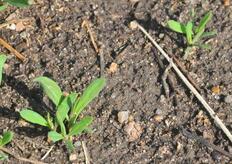 Knotweed thrives in compacted soils, so a thorough aeration is the first step in control. This weed will not compete in a healthy lawn. Chemically, there are two options. Knotweed is an annual that germinates in late February or early March, so a preemergence herbicide can be used in the late fall (about now). Pendimethalin (Scotts Halts), Surflan (Weed Impede), Barricade, Dimension and XL are labeled for knotweed. (Note: Pendimethalin, Barricade and Dimension can be used on all Kansas turfgrasses, while Surflan and XL can only be used on tall fescue and warm-season grasses such as buffalograss, zoysiagrass and bermuda). The other option is to use a combination postemergence product such as Trimec, Weed-Out, Weed-B-Gon or Weed Free Zone after the knotweed has emerged in the spring but is still young. If spring seeding of the lawn is planned, your options are more limited. Trimec and other combination postemergence herbicides require a month before overseeding to thicken up your lawn. Obviously, don't use a preemergence herbicide if you are trying to get new seed established. For homeowners seeding in the spring, tilling will control knotweed adequately without using a herbicide. If seeding without tilling (e.g., overseeding using a slicer-seeder), then use a combination product such as one mentioned above just after the knotweed comes up in the spring, and be sure to wait at least a month before seeding. (Ward Upham) 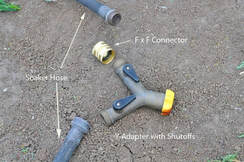 We are having another very dry fall. Watering now is important to prevent moisture stress through the winter months. A good, deep watering with moisture reaching at least a foot down into the soil is much better than several light sprinklings that just wet the top portions of the soil. A deep watering will help ensure that the majority of roots have access to water. Regardless of the watering method used, soil should be wet at least 12 inches deep. Use a metal rod, wooden dowel, electric fence post turned upside down or something similar to check depth. Dry soil is much harder to push through than wet. Although all perennial plants benefit from moist soils before winter, it is especially important for newly planted trees and shrubs due to limited root systems. Even trees and shrubs planted within the last 2 to 3 years are more sensitive to drought than a well-established plant. Evergreens are also more at risk because moisture is lost from the foliage during the winter months. Trees or shrubs planted within the last year can be watered inexpensively with a 5-gallon bucket. Drill a small hole (1/8") in the side of the bucket near the bottom. Fill the bucket and let the water dribble out slowly next to the tree. Refill the bucket once more, and you have applied 10 gallons. Very large transplanted trees and trees that were transplanted two to three years ago will require more water. A perforated soaker hose is a good way to water a newly established bed or foundation plantings. However, soaker hoses are notorious for non-uniform watering. In other words, you often receive too much water from one part of the hose and not enough from another. Hooking both the beginning and the end of the soaker hose to a Y-adapter helps equalize the pressure and therefore provide a more uniform watering. The specific parts you need are shown in the photo above and include the soaker hose, Y-adapter and female to female connector. It is also helpful if the Y-adapter has shut off valves so the volume of flow can be controlled. Too high a flow rate can allow water to run off rather than soak in. On larger trees, the soaker hose can circle the trunk at a distance within the dripline of the tree but at least ½ the distance to the dripline. The dripline of the tree is outermost reach of the branches. On smaller trees, you may circle the tree several times so that only soil which has tree roots will be watered. If using a soaker hose, note the time watering was started. Check frequently to determine the amount of time it takes for water to reach 12 inches. From then on, you can water "by the clock." Use a kitchen oven timer so you remember to move the hose or shut off the faucet. If you are seeing surface runoff, reduce the flow, or build a berm with at least a 4-foot diameter around the base of the tree to allow the water to percolate down through the soil, instead of spreading out. If we have a normal winter, watering once before spring should be adequate. However, if the winter is warm and dry, watering once a month may be needed. (Ward Upham) 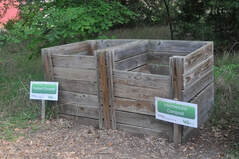 This is the time of year when there are lots of materials available to compost. Remember that the compost needs to be kept moist so that the bacteria and fungi can break down the raw materials. If you haven’t received rain recently, you may need to wet down the pile. Use a sprinkler to soak through the pile to the center. Allow the pile to drain. The goal is for the pile to remain moist; not waterlogged. Edges will dry out the quickest and may need a light sprinkling from time to time. If you are interested in composting but don’t know how it is done, see our video at http://tinyurl.com/jn6yppo. (Ward Upham) 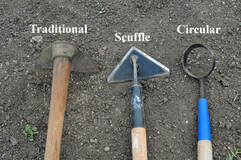 There are a number of different designs for garden hoes. My favorite three are the traditional, circular and scuffle. The traditional hoe is used to chop weeds or to lightly scrape the soil surface to kill weeds that are just emerging. Even though it is the most popular garden hoe, it is the one I use the least. The scuffle hoe is the most used hoe I own. It covers a lot of ground quickly and kills weeds without disturbing the soil as much as other hoes. Because little new soil is exposed, it is less likely to bring up weed seed that will then germinate. This type of hoe can be more difficult to find than the traditional hoe and a mail-order company may be needed. However, check with your local garden center as they are more likely to carry them than other suppliers. There is a company in Kansas that makes these hoes in several different widths as well as a number of other hoe types. All are made out of recycled disc blades. That company is Prohoe Manufacturing, LLC (https://www.prohoe.com/ ) out of Munden, Kansas. Be sure to check with your local garden center as some carry this brand of hoe in stock. The circular hoe is more specialized. It features a circular “blade” in which only the bottom is sharpened. This allows you to hoe very close to existing plants without harming them as the sides of the circle are dull. This one was invented by an Oregon Extension Master Gardener in the late nineties. Though short-handled ones are relatively easy to find, the long-handled types are more difficult. As a matter of fact, the only source I could find was from Red Pig Tools. See https://www.redpigtools.com/Circular-Hoe-Long-Handle_p_1405.html . Though these three types are my favorite, don’t be afraid to try other types to see how they work for you. (Ward Upham) 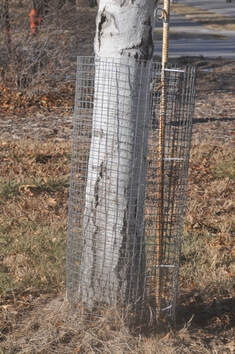 Rabbits may begin to nibble on newly planted trees and shrubs through the winter. Protect your investment with at least 2-foot-tall cylinders of 1-inch-mesh, chicken wire, or similar barrier. Remove the barrier in the spring or it can be left in place for a time. Just remember to remove it before it starts to constrict the trunk. Other control methods include plastic tree wraps and liquid rabbit repellents sprayed on the plants. Repellents will need to be reapplied each time it rains. (Ward Upham) 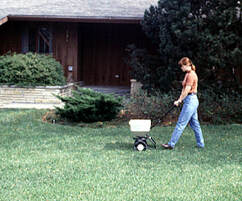 November is the time to give Kentucky bluegrass and tall fescue lawns the last nitrogen application of the season. Why November? Because while top growth slows in response to cool temperatures, grass plants are still making food (carbohydrates) by photosynthesis. A November nitrogen application helps boost the photosynthesis rate. Carbohydrates that are not used in growth are stored in the crown and other storage tissues in the plant. These carbohydrate reserves help the turfgrass green up earlier in the spring and sustain growth into May without the need for early-spring (March or April) nitrogen. Those early-spring nitrogen applications are less desirable because they can lead to excessive shoot growth and reduced root growth. Other benefits of November-applied nitrogen for cool-season grasses include improved winter hardiness, root growth and shoot density. How much should you apply? One to 1 to 1 ½ pounds actual nitrogen per 1,000 sq. ft. of lawn area is sufficient. The label rate for commercial lawn fertilizers should be within this range. In order for this application to be effective the nitrogen must be readily available to the plant because the growing season is nearly over. Therefore, for a November application, use a soluble (quickly-available) nitrogen carrier such as urea or ammonium sulfate. Many turfgrass fertilizers sold in garden centers and other retail outlets also contain soluble nitrogen and would work well at this time of year. Avoid products that contain water-insoluble nitrogen (slow-release) for this application. As always, sweep up any fertilizer that gets on driveways, sidewalks, or streets and reapply it to the lawn. (Ward Upham) |
AuthorsCynthia Domenghini runs the Horticulture Response Center in the Department of Horticulture and Natural Resources at Kansas State University. Other contributors include K-State Extension Specialists. Archives
March 2024
Categories
All
|
| K-State Research and Extension Horticulture Newsletter |
|
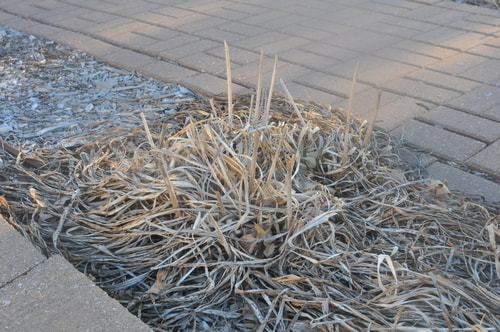
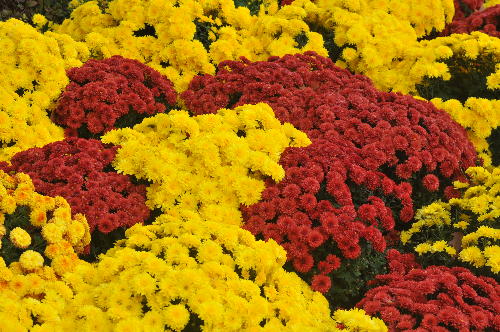
 RSS Feed
RSS Feed
